Often misunderstood and frequently sensationalized, the tarantula is a creature of remarkable beauty and ecological significance. Far from the monstrous villains of horror films, these large, hairy spiders are fascinating arachnids that play vital roles in ecosystems across the globe. From their ancient lineage to their intricate behaviors, tarantulas offer a captivating glimpse into the world of invertebrates, challenging our perceptions and inviting us to look closer at the wonders beneath our feet, or sometimes, above our heads.
This comprehensive guide delves into the intriguing world of tarantulas, offering insights for everyone from curious animal lovers and aspiring zoologists to students researching their next paper, hikers encountering them in the wild, and zookeepers dedicated to their care. Prepare to shed common misconceptions and discover the true nature of these magnificent eight-legged marvels.
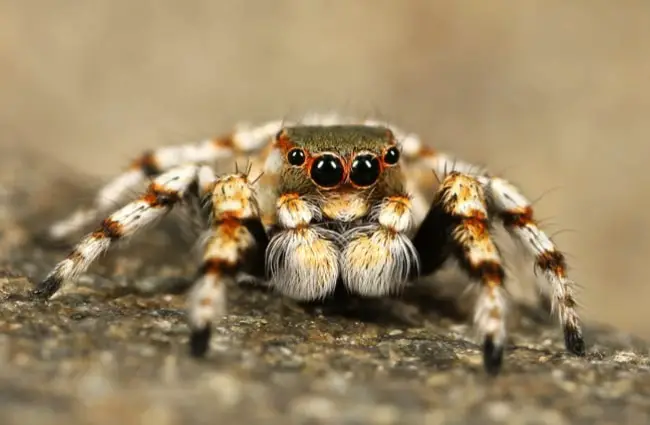
What Exactly is a Tarantula?
Tarantulas are a diverse group of large, hairy spiders belonging to the family Theraphosidae. With over 1,000 known species, they are found in various habitats worldwide. Despite their intimidating appearance, characterized by robust bodies and often impressive leg spans, most tarantulas are relatively docile and pose little threat to humans. Their common name is believed to originate from the town of Taranto in southern Italy, where a local wolf spider (not a true tarantula) was once erroneously associated with a dancing mania known as tarantism.
Physical Characteristics
- Size: Tarantulas vary greatly in size, from species with leg spans of just a few centimeters to giants like the Goliath Birdeater (Theraphosa blondi), which can boast a leg span exceeding 30 centimeters (12 inches) and weigh over 170 grams (6 ounces).
- Hair: Their bodies and legs are covered in bristles, which serve various purposes, including sensory perception and defense. Many New World tarantulas possess urticating hairs on their abdomens, which they can kick off as a defense mechanism.
- Coloration: Tarantulas exhibit a stunning array of colors, from drab browns and blacks to vibrant blues, greens, reds, and oranges, often with iridescent qualities.
- Lifespan: Females are remarkably long-lived, with some species living for 20 to 30 years or even longer in captivity. Males typically have much shorter lifespans, often only a few years, especially after reaching sexual maturity.
Where Do Tarantulas Live? Exploring Their Diverse Habitats
Tarantulas are truly global citizens, inhabiting a wide range of environments across nearly every continent except Antarctica. Their distribution is primarily concentrated in tropical and subtropical regions, but they can also be found in deserts, grasslands, and even temperate forests.
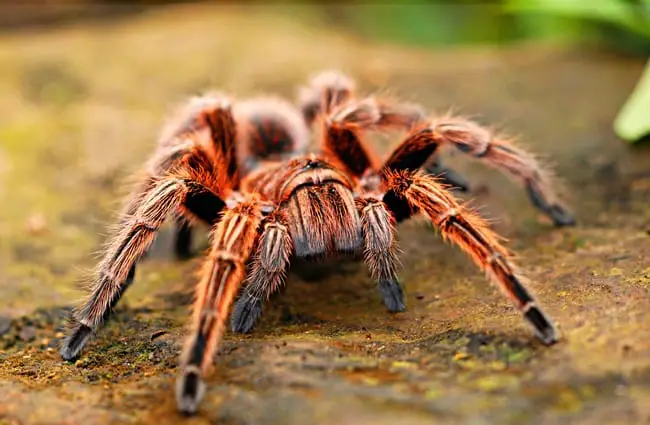
Geographical Distribution
- Americas: Abundant from the southern United States through Central and South America. This region is home to a vast diversity of species, including many popular pet tarantulas.
- Africa: Found across the continent, particularly in arid and semi-arid regions, as well as tropical forests.
- Asia: Distributed throughout Southeast Asia, India, and parts of the Middle East.
- Australia: Home to several unique genera, often referred to as “bird-eating spiders” or “whistling spiders.”
Habitat Types and Lifestyles
Tarantulas exhibit diverse lifestyles adapted to their specific environments:
- Terrestrial (Ground Dwellers): Many species are terrestrial, living on the ground. They often construct burrows, either digging their own or utilizing abandoned rodent holes, under rocks, or fallen logs. These burrows provide shelter from predators and extreme temperatures. Examples include the Chilean Rose Hair and many species from the genus Brachypelma.
- Arboreal (Tree Dwellers): Some tarantulas are arboreal, spending their lives in trees and shrubs. They build silken retreats in tree hollows, under bark, or among leaves. These species often have flatter bodies and longer legs, adapted for climbing. Examples include species from the genera Poecilotheria (Old World) and Avicularia (New World).
- Fossorial (Burrowers): These tarantulas are specialized burrowers, spending most of their lives deep underground in elaborate tunnels. They are rarely seen on the surface except during mating season or when hunting near the burrow entrance. Many African and Asian species fall into this category.
The Tarantula’s Menu: What Do These Spiders Eat?
Tarantulas are opportunistic predators, primarily feeding on insects and other invertebrates. Their diet is a testament to their role as effective hunters in their respective ecosystems.
Hunting Strategies and Prey
Most tarantulas are ambush predators, patiently waiting for prey to wander within striking distance. They detect vibrations through sensitive hairs on their legs and bodies. Once prey is detected, they quickly pounce, immobilizing it with their fangs and injecting venom.
- Primary Diet:
- Insects: Crickets, grasshoppers, beetles, cockroaches.
- Other Invertebrates: Millipedes, centipedes, scorpions, other spiders.
- Larger Prey (for bigger species):
After subduing their prey, tarantulas inject digestive enzymes that liquefy the internal tissues, allowing the spider to suck up the nutrient-rich fluid. They leave behind an undigested bolus of chitin and other hard parts.

Are Tarantulas Dangerous? Understanding Their Interaction with Humans
Despite their fearsome reputation, tarantulas are generally not considered dangerous to humans. Their venom, while effective on their prey, is typically mild to humans, comparable to a bee or wasp sting. However, their defense mechanisms warrant respect.
Venom and Bites
- Mild Venom: Tarantula venom contains neurotoxins and enzymes that break down tissues. For most humans, a bite results in localized pain, redness, swelling, and sometimes muscle cramps. Systemic reactions are rare but can occur in individuals sensitive to the venom.
- Not Lethal: There are no documented cases of a healthy human dying from a tarantula bite.
- Defensive Bites: Tarantulas bite only when they feel threatened or provoked. They prefer to flee or use other defense mechanisms first.
Urticating Hairs: A Unique Defense
Many New World tarantulas (those from the Americas) possess urticating hairs on their abdomens. These barbed bristles can be flicked off by the spider when it feels threatened, creating a cloud of irritating hairs. If these hairs come into contact with skin, eyes, or mucous membranes, they can cause itching, rashes, and inflammation. In severe cases, if inhaled, they can cause respiratory irritation.
Encountering a Tarantula in the Wild: What to Do
For hikers or anyone encountering a tarantula in its natural habitat, the best course of action is simple: observe from a distance and leave it undisturbed.
- Do Not Touch: Never attempt to pick up or provoke a tarantula. This is when bites or hair flicking are most likely to occur.
- Give Space: Allow the spider to move away on its own. If it’s in your path, simply walk around it.
- Respect Its Space: Remember that you are in its home. Tarantulas are not aggressive and will only defend themselves if they feel their life is in danger.

The Ancient Lineage: Tarantula’s Evolutionary History
Tarantulas are considered “primitive” spiders, belonging to the suborder Mygalomorphae. This group is characterized by fangs that point downwards and strike forward, unlike the more “modern” Araneomorphae spiders whose fangs cross like pincers.
Deep Roots in Time
The evolutionary history of tarantulas stretches back hundreds of millions of years. Fossil evidence suggests that mygalomorph spiders, the ancestors of modern tarantulas, were present during the Carboniferous period, over 300 million years ago. This makes them one of the oldest lineages of spiders still thriving today.
- Ancient Features: Their downward-striking fangs, lung-like book lungs (for respiration), and relatively simple silk-spinning apparatus are all considered ancient traits.
- Gondwanan Distribution: The widespread distribution of tarantulas across continents like South America, Africa, and Australia supports the theory that their ancestors were present on the supercontinent Gondwana before it broke apart. This geological separation led to the diversification of tarantula species in different landmasses.
- Slow Evolution: Compared to other spider groups, tarantulas are thought to have evolved at a slower pace, retaining many ancestral characteristics. This resilience speaks to the effectiveness of their fundamental body plan and survival strategies.
The Dance of Life: Mating and Reproduction
Tarantula reproduction is a fascinating and often perilous affair, particularly for the male.
The Mating Ritual
- Male’s Quest: Upon reaching sexual maturity, male tarantulas embark on a perilous journey to find a female. They often spin a small “sperm web” onto which they deposit sperm, then transfer it to specialized structures on their pedipalps (small, leg-like appendages near the mouth).
- Courtship Dance: When a male locates a female’s burrow, he performs a series of elaborate vibrations and taps, signaling his presence and intentions. This courtship is crucial to prevent the female from mistaking him for prey.
- Mating: If the female is receptive, she will allow the male to approach. The male uses specialized “tibial hooks” on his front legs to hold the female’s fangs, preventing her from biting him. He then inserts his pedipalps into her epigynum (genital opening) to transfer sperm.
- Post-Mating Danger: After mating, the male often makes a swift escape, as the female may attempt to eat him. Males typically die within a few months after mating, having fulfilled their reproductive purpose.
Egg Sac and Spiderlings
- Egg Laying: Several weeks or months after successful mating, the female spins a silken egg sac. She deposits hundreds to thousands of eggs into this sac, then seals it.
- Maternal Care: The female guards the egg sac fiercely, often carrying it with her or keeping it securely in her burrow. She may rotate the sac to ensure even development and protect it from mold.
- Hatching: After a period of incubation (which varies by species and environmental conditions), the eggs hatch into tiny spiderlings. These spiderlings remain within the egg sac for a time, undergoing several molts before emerging.
- Dispersion: Once the spiderlings are large enough, they disperse from the mother’s burrow, each seeking its own territory. Only a small percentage will survive to adulthood.

Tarantulas in the Web of Life: Ecosystem Contributions
Tarantulas are integral components of their ecosystems, playing crucial roles as both predators and prey.
Ecological Contributions
- Pest Control: As voracious predators of insects, tarantulas help regulate insect populations, including agricultural pests. This natural pest control benefits plant health and biodiversity.
- Soil Aeration: Burrowing species contribute to soil aeration and nutrient cycling, similar to earthworms, by creating tunnels that allow water and air to penetrate the soil.
- Food Source: Despite their size, tarantulas are not at the top of the food chain. They serve as a food source for a variety of other animals, including:
Interaction with Other Animals
Tarantulas primarily interact with other animals through predation or defense. Their cryptic coloration and nocturnal habits help them avoid detection. When threatened, they may:
- Flee: Their first line of defense is usually to run and hide.
- Threat Display: They may rear up on their hind legs, exposing their fangs and showing off their size to intimidate a potential predator.
- Urticating Hairs: As mentioned, New World species can flick irritating hairs.
- Bite: As a last resort, they will bite.
Tarantulas and Human Culture: From Fear to Fascination
Tarantulas have woven their way into human culture in diverse and often contradictory ways, inspiring both fear and admiration.
Cultural Significance
- Folklore and Mythology: In many cultures, spiders, including tarantulas, are associated with creation, weaving, trickery, and danger. Their mysterious nature has made them subjects of myths and legends.
- Media Portrayal: Unfortunately, tarantulas are frequently depicted as terrifying monsters in films and literature, contributing to widespread arachnophobia. This often overshadows their true, generally docile nature.
- Pets: In recent decades, tarantulas have become incredibly popular exotic pets. Their relatively low maintenance, long lifespans (for females), and fascinating behaviors make them appealing to enthusiasts.
- Cuisine: In some parts of the world, particularly Southeast Asia (e.g., Cambodia), tarantulas are considered a delicacy. They are often fried and consumed as a crunchy, protein-rich snack.
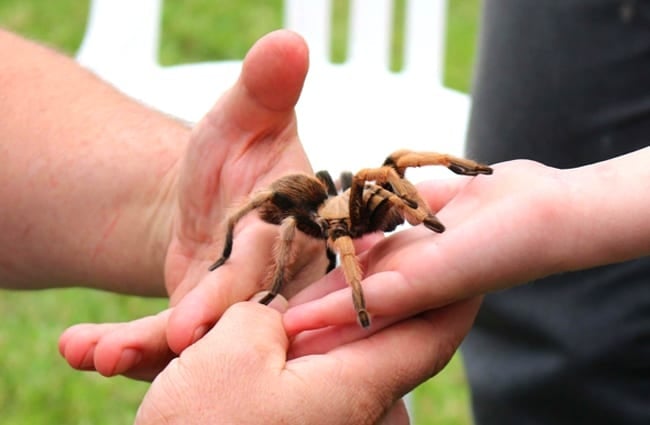
Caring for a Captive Tarantula: A Zookeeper’s Guide
For zookeepers and dedicated hobbyists, caring for tarantulas in captivity requires specific knowledge and attention to detail to ensure their health and well-being.
Essential Care Tasks
- Enclosure Setup:
- Size: A general rule is an enclosure at least 2-3 times the tarantula’s leg span in length and width. Arboreal species need height, while terrestrial and fossorial species need floor space and depth for substrate.
- Substrate: A deep layer (10-15 cm or more for burrowers) of appropriate substrate like coco fiber, peat moss, or a soil mix is crucial. It allows for burrowing and helps maintain humidity.
- Hides: Provide a secure hide (e.g., half a coconut shell, cork bark, plastic cave) where the tarantula can feel safe and retreat.
- Water Dish: A shallow, heavy water dish should always be available. For spiderlings, a bottle cap or misting can suffice.
- Ventilation: Adequate cross-ventilation is essential to prevent stagnant air and mold growth, which can be detrimental to respiratory health.
- Temperature and Humidity:
- Species-Specific: These parameters vary greatly by species. Research the natural habitat of the specific tarantula.
- Temperature: Most tropical species thrive between 22-28°C (72-82°F). Temperate species may tolerate cooler temperatures. Avoid extreme fluctuations.
- Humidity: Achieved through substrate moisture, misting (for some species), and water dishes. Too high or too low humidity can cause molting issues or dehydration.
- Feeding:
- Prey Items: Crickets, roaches, mealworms, superworms are common. Prey size should be no larger than the tarantula’s abdomen.
- Frequency: Juveniles typically eat more often (1-2 times a week) than adults (once every 1-3 weeks).
- Remove Uneaten Prey: Always remove uneaten prey after 24 hours to prevent it from stressing or harming the tarantula, especially during molting.
- Molting Care:
- Vulnerability: Tarantulas are extremely vulnerable during and immediately after molting (shedding their exoskeleton).
- Do Not Disturb: Never handle or feed a tarantula that is in pre-molt (often lethargic, dull colors) or post-molt (soft, fragile exoskeleton).
- Ensure Humidity: Proper humidity is vital for a successful molt.
- Hygiene: Regular spot cleaning and occasional full substrate changes are necessary to prevent bacterial or fungal growth.
What to Avoid
- Handling: While some tarantulas tolerate handling, it is generally discouraged. It stresses the spider, and a fall can be fatal due to their fragile abdomens. Bites and urticating hairs are also risks.
- Cohabitation: Never house multiple tarantulas together. They are solitary and will likely cannibalize each other.
- Wild-Caught Specimens: Whenever possible, acquire captive-bred tarantulas to support conservation efforts and avoid introducing parasites or diseases.
- Overfeeding: Can lead to health issues and a shorter lifespan.
- Direct Sunlight: Can quickly overheat and kill a tarantula.

Fascinating Facts About Tarantulas
Beyond the basics, tarantulas hold a treasure trove of intriguing details:
- “Hair Kicking”: New World tarantulas can defend themselves by rapidly rubbing their hind legs over their abdomen, launching a cloud of irritating urticating hairs at a perceived threat.
- Regenerative Abilities: Tarantulas can regenerate lost limbs over several molts, though the new limb may be smaller initially.
- Silk Production: While not known for elaborate webs like orb-weavers, tarantulas use silk for various purposes: lining burrows, creating egg sacs, sealing off their retreats, and even as a “tripwire” around their burrow entrance.
- Longevity: Female tarantulas are among the longest-lived invertebrates, with some species living for 25-30 years or more in captivity. Males, however, live significantly shorter lives, especially after reaching sexual maturity.
- Molting: Tarantulas grow by molting, shedding their old exoskeleton. This process can be stressful and dangerous, but it allows them to increase in size and even repair minor injuries.
- Nocturnal Hunters: Most tarantulas are nocturnal, emerging from their burrows or retreats at night to hunt.
- Sensitive Hairs: The hairs covering their bodies are highly sensitive, allowing them to detect vibrations, air currents, and even chemical cues in their environment.
- “Pet Rocks”: Some tarantula species, particularly the Chilean Rose Hair, are known for being quite sedentary, often sitting in the same spot for extended periods, earning them the affectionate nickname “pet rocks” among enthusiasts.
- Not All Hairy Spiders are Tarantulas: Many other large, hairy spiders exist, such as wolf spiders, but they belong to different families and lack the specific characteristics of true tarantulas.
- Fangs and Venom: Their fangs are hollow and used to inject venom. The venom is primarily designed to paralyze and digest their invertebrate prey.
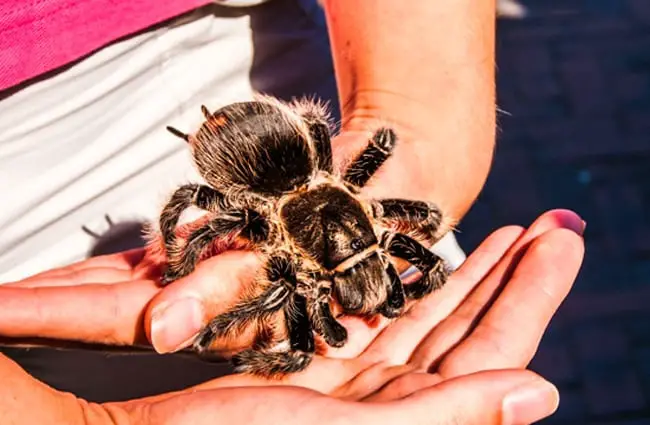
Conclusion: A Call for Appreciation
From their ancient origins to their diverse roles in modern ecosystems, tarantulas are far more than just “scary spiders.” They are complex, fascinating creatures with intricate behaviors, unique adaptations, and a quiet beauty that often goes unnoticed. By understanding their habitats, diets, reproductive cycles, and interactions with the world around them, we can move beyond unfounded fears and develop a genuine appreciation for these remarkable arachnids.
Whether you are an aspiring zoologist, a student researching a paper, an animal lover seeking to understand wildlife, a hiker encountering one in nature, or a zookeeper dedicated to their care, the world of tarantulas offers endless opportunities for discovery and respect. Let us continue to learn from and protect these incredible inhabitants of our planet.

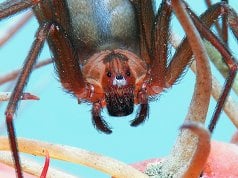
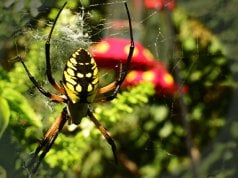



![Red Angus Closeup of a beautiful Red Angus cowPhoto by: U.S. Department of Agriculture [pubic domain]https://creativecommons.org/licenses/by/2.0/](https://animals.net/wp-content/uploads/2020/03/Red-Angus-4-100x75.jpg)

